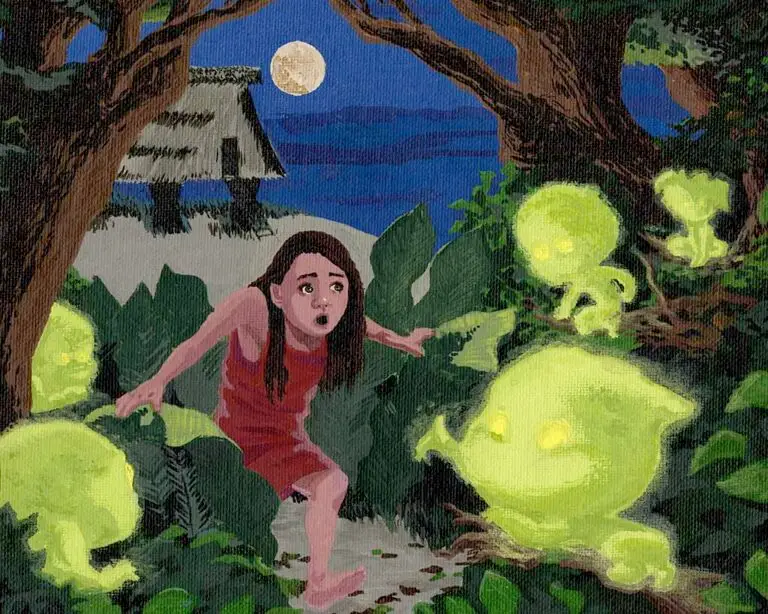CHamoru/Chamorro Duhendes

I’ve grown up with a tremendous fascination for talk story. I’m going to share a bit of folklore in the hope that the young ones will initiate discussions at home especially because stay-at-home situations, as we have throughout this pandemic, foster talking and sharing.
I believe in the duhendes and everything connected to them. Stories abounded in childhood and often I’d put myself in a trance just concocting tales of adventure and mischief. I consider the duhendes an important part of my culture. I even wrote a play, a musical one, and it delighted Guam audiences.
I learned about them when I’d massage my mother in the dead of night. The method of massage that I did was to walk atop the back of her body – that was called ugot. While doing this, she’d regale me with stories of the duhendes. My mother’s bedroom overlooked our backyard that was jungle in those early days of pre-urban Sinajana village. As she told a story, I’d look out the louvered windows to the deep darkness of the backyard. Her stories and my massaging were almost nightly so my interest and fascination were immeasurable.
Despite being sleepy, I’d dutifully walk back and forth as she’d tell me about these little beings. She described them as little people, not any larger than the fingers of the hand, that of a child or even an adult. My inkling of her description reminded me of the story of Thumbelina from storybook fame. She said that they didn’t speak a word, only jibberish and the only one who’d understand them was a child, boy or girl, who was very active, tireless and energetic and loved to talk.
The duhendes played. They’d be very active especially on rainy nights when the wind was still. They engaged in hide-and-seek, tag, pull hair among one another, swing on vines and slide down leaves of trees and shrubs dripping from the rain. They’d also use these vines to jump rope or fashion them into swings so they’d sway to and fro. They loved the rainstorm but any wind would blow about their fragile bodies and when it was windy they’d stay in the shadows of limbs, roots, and other vegetation until the wind stopped.
They’d also appear on hot, sunny days usually at exactly noon. Again, it had to be windless as a breeze would dispel their bodies and they’d disappear until another time. When seen during the day, they’d be hiding in small shrubs and bushes, busy picking nits from each other’s hair or giggling about some joke they’d share and oftentimes, their eyes dart back and forth as they look at humans. Their presence was unpredictable and many sightings occurred and they were seen by people who were often caught off guard.
They wore simple clothing that was either an earthy hue of bland colors, mostly grays and light brown. They’d appear dirty, disheveled and carefree. Their style of attire was indescribable because it was their manner that captured the attention of people rather than their appearance. They loved children whom I described as those who are active, energetic and loved to talk. It is the duhendes that take these children into captivity usually lasting 24 hours. It was believed that the duhendes would derive their own energy from the children that were taken.
The children are often returned to the spot where they were last seen. They’re unable to speak and need to be spanked by a certain belt. Parents would seek a woman who was a church leader and possessed what was called a kurehas kufradiha. This kurehas was a belt made from leftover fabric and twisted and fastened by hand that was then blessed by a Catholic priest. It was said that the belt was usually kept in the “kaohao”, a chest of the woman who made it and only used on special occasions that included the spanking of the child who’d just been released by the duhendes.
Once spanked, the child would then resume normalcy in both behavior and speech. The reason the child couldn’t speak when found was that all his or her energy was drained, taken up by the duhendes.
If any of the duhendes was disturbed, retaliation with vengeance would ensue and it was believed that it was done mostly to adults. They are somehow connected to having an adult subjected to chotnot maipe that would be the work of the taotaomo’na.
Peter R. Onedera is a playwright, author, poet, a master storyteller and a CHamoru language educator.
